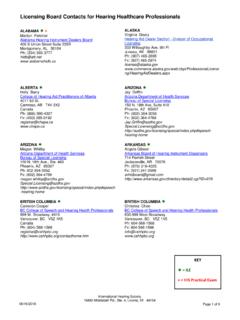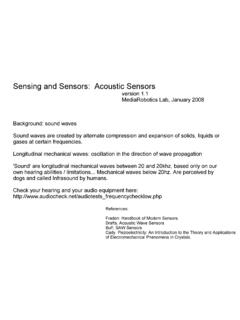Transcription of Welcome to ACOUSTIC REFLEX TESTING: …
1 IHS Organizers Ted Annis Senior Marketing Specialist Welcome to ACOUSTIC REFLEX TESTING: METHODOLOGY, INTERPRETATION, AND CLINICAL USES Presenter: Ted Venema, PhD Faculty, HIS Program Ozarks Technical Community College Springfield, MO Fran Vincent Marketing and Membership Manager Housekeeping This presentation is being recorded CE credit is available! Visit for details Note taking handouts are available at on the webinar page. Feel free to download now! Agenda A quick review of tympanometry ACOUSTIC reflexes: contralateral and ipsilateral Interpreting ACOUSTIC reflexes Q&A (enter questions in Question Box any time) A QUICK REVIEW OF TYMPANOMETRY Tympanometry normally consists of four tests types compliance volume of EAM reflexes Function of the middle ear It increases sound pressure in three ways: 1. TM is larger than footplate of Stapes (17:1) 2.
2 Leverage action of ossicles (Malleus is :1 longer than Incus) 3. Buckling action of TM (2:1) 1. 1. 2. Umbo TM at rest Buckling action 3. 2. Results in decibels The middle ear must increase the pressure of air-borne sound because the cochlea is filled with fluid! 0 10 100 1000 10,000 100,000 1,000,000 120 100 80 60 40 20 0 Pressure Increase dB SPL 44:1 33 In Summary: 1. Eardrum Stapes size: 17:1 2. Ossicles leverage action: :1 3. Eardrum buckling action: X 2:1 44:1 This corresponds to an increase between 30-35 dB Key concept behind tympanometry For the middle ear to be most Air pressure must be even on both sides of TM External Auditory Meatus (EAM) Tympanometry is really a test of middle ear efficiency When air pressure is equal on both sides of TM, this creates least stiffness.
3 Most compliance Speaker Tone in Microphone Tone out Air Pressure changes With greatest middle ear compliance The middle ear is the least stiff, and it offers least overall Impedance This means more sound will be able to go through it, and less sound will be impeded by it Tympanometry measures this Low Hz (226Hz) tone at about 70 dB Bounces off normally stiff middle ear system Speaker Tone in Microphone Tone out Air Pressure changes It is supposed s what you want otherwise, you have nothing to measure! Test 1: The tympanogram; stages of otitis media Negative 0 Positive Air Pressure Compliance High Low Type A Type C Type B Type C going to Type B Type A = Normal Type C = Early OM with negative middle ear pressure Type B = Advanced OM with fluid Test 2: Static compliance oto-sclerosis, disarticulated ossicles, etc.
4 Negative 0 Positive Compliance High Low Lots of complicated explanations around about static compliance It basically refers to the height of one s tympanogram! How tall is your tent! Various pathologies affect static compliance Type As Type Ad Test 3: Physical volume (PV) of ear canal Normally between to A large PV might indicate a perforated TM True type B tympanogram has normal PV If type B with tiny PV, then probe tip against outer ear canal wall TEST 4: ACOUSTIC Reflexes Contralateral and Ipsilateral Location of Stapedius muscle Lass & Woodford Hearing Science Fundamentals Fig 2-9 Location of tensor tympani muscle Lass & Woodford Hearing Science Fundamentals Fig 2-10 The ACOUSTIC REFLEX arc Afferent (going to the brain) path Efferent (going from the brain stem) path back to the middle ears Note crossover.
5 A loud sound to one ear causes an AR in both ears CN SOCs VIII nerve Loud Sound TT S V Nerve VII Nerve VII Nerve V Nerve S TT Afferent Route Loud incoming sound Middle ear Cochlea VIII Nerve Cochlear Nucleus (CN) Superior Olivary Complex s (SOCs) Efferent Route V Nerve VII Nerve Tensor Tympani muscle (TT) Stapedius muscle (S) Brain Stem Why do we have ACOUSTIC reflexes? Ever listened to a recording of you? You are the only one who hates the sound Everyone else thinks it sounds just like you That s because you are hearing yourself by AC only AC is how others hear you Normally, you hear yourself by BC as well Voice tone is richer, a bit lower Also louder, which causes ACOUSTIC REFLEX By AC, normal speech is 65 dB SPL By AC and BC, your voice is closer to 80-85 dB SPL The purpose of ACOUSTIC reflexes is: Not to protect against NIHL One of the fallacies we are commonly lead to believe ARs occur especially while we speak they actually kick in about 50 msec before we talk Note ARs strongest for low Hz s (500, 1000Hz) This is because our voices are louder for vowels ARs reduce upward spread of masking Allow us to hear better while talking All mammals have them Musiek & Rintelmann ARs are a low Hz phenomenon With ARs, you are still using tympanometry Measuring how much 226 Hz tone is bouncing off But while tympanometry changes middle ear compliance by: Air pressures ARs change middle ear compliance by Loud sounds!
6 ARs are done at static compliance At the air pressure yielding highest tympanogram ARs thus normally restricted for: Normal or near-normal tympanograms The ACOUSTIC REFLEX and tympanometry ACOUSTIC REFLEX causes a temporary reduction in static compliance Negative 0 Positive Air Pressure Compliance High Low Normal Static Compliance Reduced Static Compliance Due to ACOUSTIC REFLEX Musiek and Rintelmann ACOUSTIC reflexes are measured as temporary decreases in compliance (admittance) Think of a temporary drop in the tympanogram peak (static compliance) while the loud AR stimulus is presented The results here are shown for a 1000 Hz tone presented for one second AR stimuli: 500 or 1000Hz tones at 85 to 110 dB HL These are presented with headphone Ongoing 226 Hz tone at 70 dB SPL in opposite ear measures AR SPL increase at probe microphone indicates an AR Contralateral ARs were first to be developed 500 or 1000 Hz AR stimulus tone Ipsilateral ARs came later AR stimuli: 500 or 1000Hz tones at 85 to 110 dB HL Ongoing 226 Hz tone at 70 dB SPL in same ear measure AR!
7 SPL increase at probe microphone indicate an AR Katz Handbook 5th edition, page 207 Stimulus and Probe in RE Stimulus in LE Probe in RE Stimulus in RE Probe in LE Stimulus and Probe in LE ACOUSTIC REFLEX is always reported according to ear that got the stimulus INTERPRETING ACOUSTIC REFLEXES Hah! Martin, F. Introduction to Audiology Seriously Previous slide highlights why we don t do both ipsilateral and contralateral ARs anymore Cases A - F show conductive HL or SNHL Note how if you cannot get ipsilateral ARs, you cannot get contralateral ARs Similarly, if you cannot get contralateral ARs, then you cannot get ipsilateral ARs That s why for these cases, just run either ipsi or contra ARs Cases G - K show retro-cochlear pathology Note very different ipsilateral and contralateral AR patterns Here it would make sense to run both ipsilateral and contralateral ARs That however, was yesterday.
8 This is today If you suspect retro-cochlear pathology Refer to an Audiologist who will run an ABR to look for retro-cochlear pathology or to a physician who will do a CT scans or an MRI to look for the same ARs reported in sensation level (SL) ARs tested in dB HL (tympanometer calibrated in dB HL) ARs normally found between 80-100 dB HL ARs reported in dB SL (always relative to one s own thresholds) ARs can be tested at 500, 1000, 2000 or 4000 Hz Normal and mild-moderate SNHL May have ARs at similar dB HL But at very different SLs Eg: Normal HL and flat 50 dB SNHL may have ARs at 100 dB HL But normal HL has ARs at 100 dB SL The SNHL has ARs at 50 dB SL Katz Handbook of Clinical Audiology 5th edition, Conductive HL tends to obliterate ARs Case of unilateral conductive HL Contralateral ARs with loud stimulus to bad ear: HL in bad ear prevents intensity required to cause AR in opposite ear Contralateral ARs with loud stimulus to good ear: Mechanical middle ear problems in bad ear prevent AR Ipsilateral AR absent in bad ear Result: Only good ear Ipsilateral AR present Katz Handbook of Clinical Audiology 5th edition, Conductive HL tends to obliterate ARs Bilateral conductive HL Contralateral and ipsilateral ARs all absent Note: The SL for ARs tends to decrease linearly as the degree of SNHL increases up to about 60 dB HL ARs and SNHL From Clinical Impedance Audiometry 2nd ed Jerger, Northern Note: SL decreases in almost exact proportion to degree of SNHL!
9 SNHL and reduced SL Absent ARs and SNHL Note: Absence of ARs Increases dramatically with SNHL of 60 dB HL or more Katz Handbook of Clinical Audiology 5th edition, Contralateral & Ipsilateral ARs Present Bilateral SNHL and ARs Unilateral SNHL (VIII Nerve Tumor) RE: Contralateral & Ipsilateral ARs normal LE: Contralateral ARs elevated; Ipsilateral ARs absent Katz Handbook of Clinical Audiology 5th edition, Katz Handbook of Clinical Audiology 5th edition, Abnormal contra and ipsi ARs in client with intra-axial brain stem lesion Musiek & Rintelmann Contemporary Perspectives in Hearing Assessment Relationship between degree of HL and absent ARs in SNHL vs VIII nerve pathology ARs and speech discrimination AR deals with IHCs AR arc: IHCs send afferent information to VIII nerve IHCs are critical part of AR arc OAEs deal with OHCs Cochlea: OHCs receive efferent information OHCs not involved with AR arc Two people with same moderate SNHL May have very different SD One with good SD probably has ARs at reduced SLs One with poor SD probably has absent ARs ACOUSTIC reflexes involve inner hair cells Fig 1-7, Venema, T.
10 Compression for Clinicians 2nd edition, Thomson Delmar Learning 2006 A very unique test under used today Oto- ACOUSTIC emissions involve outer hair cells Both are non-behavioral both obliterated by middle ear pathology They therefore make great cross tests Questions Enter your question in the Question Box on your webinar dashboard Thank you for attending! Contact Ted Venema PhD: For more info on obtaining a CE credit for this webinar, visit









